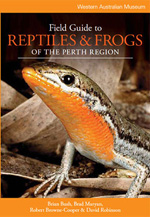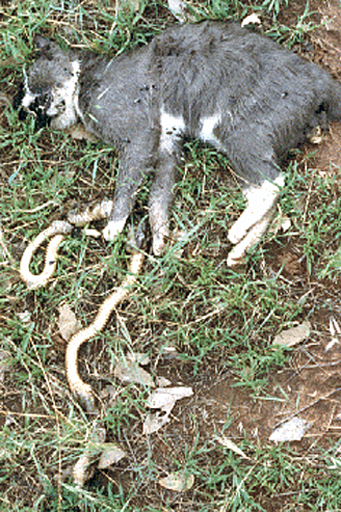
2010 - Field Guide to Reptiles and Frogs of the Perth Region
 Dead domestic cat and Western brown snake (Pseudonaja mengdeni). One can assume the cat attacked the snake and killed it before succumbing to the snake's venom.
Dead domestic cat and Western brown snake (Pseudonaja mengdeni). One can assume the cat attacked the snake and killed it before succumbing to the snake's venom.1. Inquisitive nature or fun in puppies and young dogs. The snake may be no more than a rustle in the grass but the dog can not resist chasing the sound and pouncing up and down in the grass in search of the source, or the snake may be in the open and the dog considers it something to play with. In either case the snake may behave in a defensive way by biting. Although older dogs are similarly at risk, they are often less interested. However the following behavioural trait is more likely to manifest itself in older dogs.
2. Hunting and territorial behaviours are to some extent breed-specific. If a snake moves through the yard these dogs are quick to attack it. In many cases they are successful, however as a dog's reflexes slow down with age there is an increasing likelihood of snakebite.
Cats are natural hunters and often find snakes. A problem to owners of snake-catching cats is their habit of returning to the house with a live snake. Little will discourage cats from hunting snakes.
When exercising a dog in bushland during spring, summer and autumn, it is advisable to restrain it on a leash. If the dog is exercised, choose an open area where you can have visual contact with it always.
Dogs are more susceptible to the venoms of snakes than cats. If it involves a large venomous snake then the prognosis is rarely good. Even so, if there are signs of life, with the correct antivenom dogs can make a remarkable recovery. Often it is the case with work-dogs on the farm that death occurs in the vehicle on the way to town.
In the Perth area two common snakes bite dogs and cats. One is the Dugite or Spotted Brown Snake (Pseudonaja affinis), a very mobile, nomadic snake that has small fangs and small yields of very toxic venom. Often the symptoms are slow in onset and include a progressive paralysis beginning at the back legs and extending forward. It is not uncommon to observe a dog or cat after a bite from a Dugite having problems supporting the hind part of the body. Eventually paralysis becomes total with a lolling of the tongue, non-responsive pupils and laboured breathing. Brown Snake antivenom is used for bites from this species and the Gwardar or Western Brown Snake (P. mengdeni).
The other is the Tiger Snake (Notechis scutatus). Dogs bitten by this species become very agitated immediately after and display hyper-activity for a brief period before collapsing in an unconscious state with lolling tongue and laboured breathing. Although cats may display a similar response they are more likely to seek out a quiet place and rest. They progressively become more lethargic until death or recovery.
Although Death Adders (Acanthophis antarcticus) and Mulga Snakes (Pseudechis australis) are widespread in Australia they are rarely involved locally.
If a bite on a limb is observed apply a pressure bandage to retard absorption of venom. For bites on the body apply local pressure with the hand. If the snake has been found and killed take it with the dog for identification. If the dog is in an advanced state of collapse do not hesitate in getting it to a veterinary surgeon.
